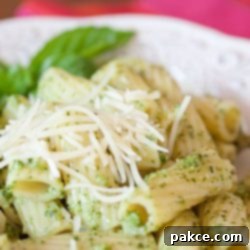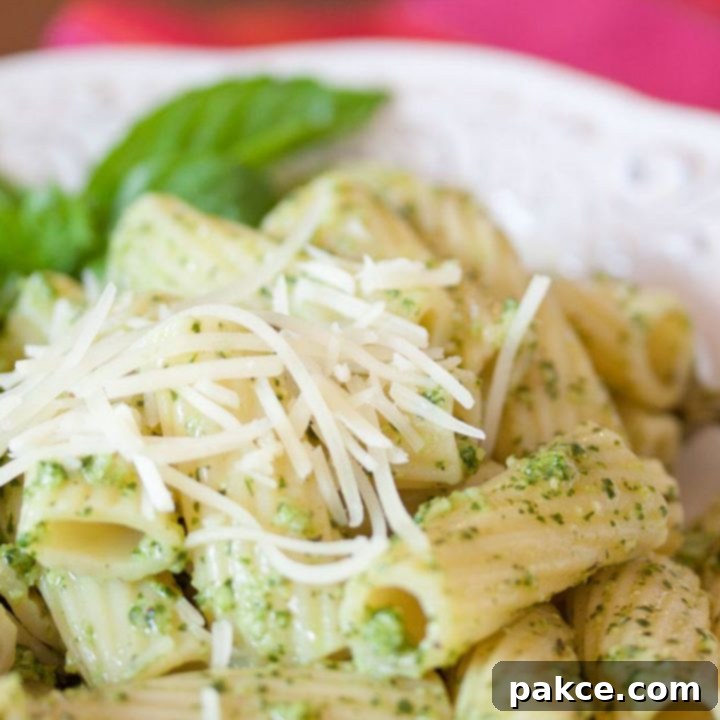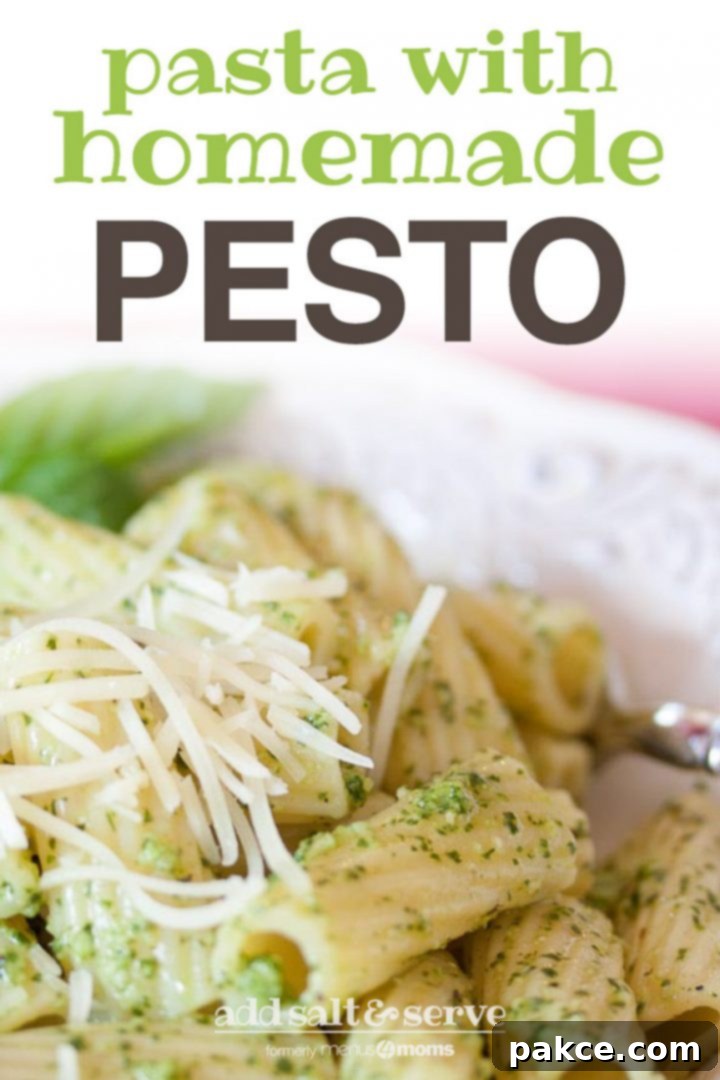Mastering Homemade Pesto Pasta: A Quick & Flavorful Recipe Guide
Imagine a vibrant, aromatic pasta dish that comes together faster than your water can even begin to boil. That’s the undeniable magic of homemade pesto pasta! Forget bland, store-bought jars; crafting your own fresh basil pesto is surprisingly simple and elevates this beloved Italian meal to an entirely new level. This comprehensive guide will walk you through a straightforward recipe for a delightful pesto rigatoni and delve into everything you need to know to make it a cherished staple in your kitchen.
Homemade pesto is not just incredibly quick to prepare; it’s a veritable burst of fresh, herbaceous flavor that perfectly complements a multitude of dishes. In the very short time it takes for your pasta to reach that perfect al dente bite, you can have a rich, gloriously green, and wonderfully fragrant pesto sauce ready to toss. Below, you’ll discover our complete, easy-to-follow recipe for Pasta with Homemade Pesto, including all the essential ingredients and clear, step-by-step instructions for preparing both the pasta and the undisputed star of the show – your very own freshly blended pesto.

Recipe

Pasta with Homemade Pesto
Add to Shopping ListGo to Shopping List
Ingredients
Pasta & Garnish
- 16 oz rigatoni
- ½ cup Parmesan cheese, for garnish
Pesto
- 2 cups fresh basil leaves
- ¼ cup Parmesan cheese
- ½ cup olive oil
- 3 tablespoons pine nuts
- 3 cloves garlic
Instructions
Boil the pasta
-
Prepare 16 oz rigatoni according to package directions.
Make the pesto
-
While the pasta is cooking, make the pesto.
-
Flatten 3 cloves garlic with the side of a knife and coarsely chop.
-
Place 2 cups fresh basil leaves into a food processor and process until well chopped.
-
Add a third of the 3 tablespoons pine nuts and ⅓ of the chopped garlic and blend again.
-
Add about a third of the ¼ cup Parmesan cheese and blend slowly while adding about a third of the ½ cup olive oil.
-
Stop to scrape the sides of the food processor, pushing the contents toward the bottom. Process until a smooth, think paste if formed.
-
Repeat the process twice more with the remaining pesto ingredients until all pesto ingredients are used.
Combine, garnish, and serve
-
Add homemade pesto to prepared rigatoni and toss to coat.
-
Garnish with ½ cup Parmesan cheese and serve.
Nutrition per serving
Share
Pin
Why Choose Homemade Pesto? The Benefits are Endless!
While convenient, jarred pesto simply cannot compare to the vibrant taste and intoxicating aroma of a freshly made batch. Homemade pesto offers a multitude of advantages that make the little extra effort incredibly worthwhile:
- Unmatched Freshness: The absolute cornerstone of exceptional pesto is fresh basil. When you make it yourself, you capture the peak flavor and delicate fragrance that is almost always lost in commercially processed products.
- Complete Control Over Ingredients: You are the master of your pesto. This means you get to hand-pick high-quality extra virgin olive oil, crisp, fresh garlic, and premium Parmesan cheese. This control also allows for easy dietary adjustments, such as reducing sodium, opting for organic ingredients, or experimenting with nut-free alternatives for those with allergies.
- No Preservatives or Artificial Flavors: Commercial pestos often contain various additives, artificial colors, and preservatives designed to extend shelf life. Your homemade version, however, is pure, unadulterated natural goodness, free from any unwanted extras.
- Customizable Flavor Profile: Do you prefer a more pronounced garlic kick? Perhaps a milder cheese flavor? Or maybe a bright hint of lemon? With homemade pesto, you can effortlessly adjust the ratios of ingredients to perfectly suit your personal palate and culinary desires.
- Economical Choice: Often, crafting pesto from scratch can be more cost-effective in the long run, especially if you have a thriving basil plant in your garden or find fresh basil on sale. It’s an investment in flavor that pays off.
The Essential Ingredients of Pesto and How to Choose Them
Traditional pesto alla Genovese relies on a few core ingredients, each playing a critical role in developing its distinct and harmonious flavor and texture. Understanding these fundamental components will empower you to create the very best pesto every single time:
Fresh Basil Leaves: The Soul of Pesto
For an authentic and truly exquisite pesto, sweet basil is absolutely non-negotiable. When selecting, seek out bright green, unbruised leaves that possess a strong, inviting, and sweet aroma. Steer clear of any basil that appears wilted or has dark spots, as these indicate a loss of freshness. The fresher the basil, the more vibrant and flavorful your pesto will ultimately be.
Parmesan Cheese: The Salty, Umami Heart
Authentic Parmigiano-Reggiano delivers a nutty, salty, and deeply savory umami flavor that is absolutely essential to classic pesto. For the finest texture and taste, always grate it freshly yourself. Pre-grated cheeses often contain anti-caking agents that can negatively affect the pesto’s smooth consistency and overall flavor. Pecorino Romano, with its sharper, more pungent profile, is another excellent option, sometimes used in combination with Parmesan for an even bolder taste.
Olive Oil: The Silky Binder
High-quality extra virgin olive oil is the crucial binding agent and a significant contributor to the pesto’s character. Its fruity, sometimes peppery or grassy notes contribute significantly to the pesto’s overall flavor complexity. Always use a good quality oil, as its taste will genuinely shine through in the final product. Add it slowly and steadily while blending to achieve that perfect emulsified, smooth, and luscious consistency without making the pesto excessively oily.
Pine Nuts: The Creamy Crunch
Pine nuts impart a subtle sweetness and contribute to a creamy texture when finely blended into the sauce. Lightly toasting them in a dry pan before adding can profoundly enhance their inherent nutty flavor and aroma. If pine nuts are proving to be too expensive or if you have a nut allergy, blanched walnuts or even almonds can serve as decent alternatives, though it’s important to note that they will slightly alter the classic taste profile.
Garlic: The Aromatic Kick
Fresh garlic cloves are an indispensable ingredient, providing a pungent, aromatic kick that cuts through the richness of the oil and cheese. Our recipe calls for three cloves, but feel entirely free to adjust this quantity to your personal preference – more for a bolder, spicier flavor, or less for a milder, more subtle one. Flattening and coarsely chopping them before blending helps them integrate more easily and efficiently releases their powerful aromatic compounds.
Tips for Crafting the Perfect Pesto
Making pesto is often less about adhering to strict, rigid measurements and more about achieving the ideal balance of flavors and the desired consistency. Here are some invaluable tips to ensure your homemade pesto is a resounding success every time you prepare it:
- Utilize a Food Processor (or Embrace the Mortar and Pestle): A modern food processor makes quick, effortless work of pesto preparation, turning leaves and nuts into a smooth paste in minutes. Add ingredients in stages as directed in the recipe to ensure everything is thoroughly and evenly chopped and beautifully combined. If you prefer the traditional, time-honored method, a mortar and pestle will yield an even more rustic texture and, arguably, a more intense and nuanced flavor due to the slower, crushing action that extracts more oils from the ingredients.
- Process in Small Batches: Resist the temptation to overload your food processor. Processing the basil, nuts, and garlic in smaller, manageable batches helps ensure that they chop evenly and prevents the machine from overheating.
- Drizzle Olive Oil Slowly: This step is absolutely critical for achieving a beautifully emulsified pesto. A slow, steady stream of extra virgin olive oil added while the food processor is running (or while you’re steadily grinding with a mortar and pestle) helps create a smooth, creamy, and cohesive pesto rather than a separated or greasy one.
- Taste and Adjust Seasoning: Always, always taste your pesto before mixing it with the pasta. This allows you to fine-tune the flavors. You might discover it needs a pinch more salt, a refreshing squeeze of lemon juice (which also helps brighten the flavor and can prevent browning), or a bit more cheese to achieve perfection.
- Avoid Over-Processing: Be mindful not to over-process the ingredients. Excessive blending can generate heat, causing the delicate basil to oxidize and potentially turn a less appealing brownish-green color. Use quick pulses rather than continuous blending to keep the pesto vibrantly bright green.
Choosing the Right Pasta for Pesto
While pesto is wonderfully versatile and pairs well with many pasta varieties, certain shapes are inherently better suited for truly holding onto and showcasing the rich, flavorful sauce. Our recipe thoughtfully suggests rigatoni, and for very good reasons!
- Rigatoni: The large, distinctively ridged tubes of rigatoni are absolutely perfect for capturing and holding thick, luscious pesto sauce. Each and every bite delivers a generous and satisfying coating of the flavorful green goodness.
- Other Excellent Pasta Choices: For those who enjoy variety, here are other pasta shapes that work exceptionally well with pesto:
- Fusilli or Rotini: Their delightful corkscrew shapes are fantastic for trapping every last bit of pesto in their crevices.
- Penne: Similar in shape and function to rigatoni, penne’s tubular form and subtle ridges also work beautifully to scoop up the sauce.
- Linguine or Fettuccine: For a more classic “long pasta” experience, these flat, broad noodles provide an ample surface area for the pesto to cling to, ensuring every strand is coated.
- Orecchiette: These charming “little ears” pasta shapes are designed to cup the pesto exquisitely, creating delightful pockets of flavor.
Regardless of your choice, always remember to cook your pasta al dente – meaning “to the tooth” – firm but with a slight bite, never mushy. This ensures it maintains its structural integrity and provides a satisfying mouthfeel when generously tossed with your delicious homemade pesto.
Beyond Pasta: Creative Ways to Enjoy Homemade Pesto
Once you’ve mastered the art of making this fresh, versatile pesto, you’ll find countless delightful ways to incorporate its vibrant flavors into almost any meal. It’s truly not just for pasta anymore! Here are some inspiring ideas to expand your culinary repertoire:
- Flavorful Spread: Use it generously as a vibrant, herbaceous spread for sandwiches, wraps, crusty bread, or even morning toast for an unexpected savory kick.
- Gourmet Pizza Base: Ditch the traditional tomato sauce and spread a thin, tantalizing layer of pesto as the base for a fresh, unique, and incredibly flavorful pizza.
- Zesty Salad Dressing: Thin your pesto out with a little extra olive oil, a splash of white wine vinegar, or a squeeze of fresh lemon juice to create an instant, exquisite salad dressing.
- Dynamic Marinade: It makes an exceptional marinade! Use it to infuse chicken, fish (especially salmon or cod), shrimp, or firm tofu with a burst of aromatic, herbaceous flavor before grilling or baking.
- Vegetable Enhancer: Toss warm roasted vegetables (such as tender asparagus, crisp green beans, roasted potatoes, or cherry tomatoes) with a spoonful of pesto for an instant and dramatic flavor upgrade.
- Elegant Soup Topping: Swirl a generous spoonful of pesto into hot soups, particularly vegetable, minestrone, or even a simple tomato soup, just before serving to add richness and a fresh dimension.
- Breakfast Brilliance: A dollop of pesto on scrambled eggs, a fluffy omelet, or a rustic frittata adds a wonderful brightness and gourmet touch to your breakfast or brunch.
- Savory Compound Butter: Mix softened butter with pesto for a flavorful compound butter. Use it to melt over grilled steak, a baked potato, or simply spread it on warm dinner rolls.
Storage and Freezing Homemade Pesto
Making a larger batch of pesto is always a fantastic idea, as it stores beautifully and can be a lifesaver for quick meals later. Here’s how to properly store your homemade pesto to maintain its fresh taste and vibrant color:
- Refrigeration: Store fresh pesto in an airtight container in the refrigerator for up to a week. To effectively prevent oxidation (which causes browning) and preserve its bright green color, always pour a thin, protective layer of olive oil over the top of the pesto before sealing the container.
- Freezing for Long-Term Freshness: Pesto freezes exceptionally well and can be kept frozen for up to 6 months without significant loss of quality.
- Ice Cube Trays: This is a highly recommended method for convenient, single-serving portions. Freeze individual dollops or cubes of pesto in ice cube trays. Once completely frozen solid, transfer the pesto cubes to a freezer-safe bag or an airtight container. These cubes are perfect for quickly adding to sauces, soups, or for thawing just enough for a single pasta dish.
- Small Airtight Containers: Alternatively, freeze pesto in small airtight containers, again ensuring you pour a thin layer of olive oil over the top before freezing. This method is great for larger portions if you plan to use more at once.
When you’re ready to use it, simply thaw frozen pesto overnight in the refrigerator, or for a quicker solution, run warm water over the sealed container until it’s pliable.
Conclusion: A Fresh, Fast, and Flavorful Meal Awaits
Homemade pesto pasta is so much more than just a simple meal; it’s an experience of fresh, vibrant, and deeply satisfying flavors brought together with remarkable ease and speed. This quick stovetop dish, featuring the rich, aromatic homemade pesto and hearty rigatoni, is an ideal choice for busy weeknights when time is short, yet you crave something truly delicious and wholesome. It’s also perfect for a relaxed weekend lunch with loved ones. With just a few basic, fresh ingredients and the magic of a food processor, you possess the power to create a culinary masterpiece that will undoubtedly impress your family and friends. So, go ahead – gather your freshest basil, fire up the stove, and prepare to immerse yourself in the unparalleled taste of freshly made pesto pasta. Happy cooking, and enjoy every delightful bite!
Pin this recipe:


